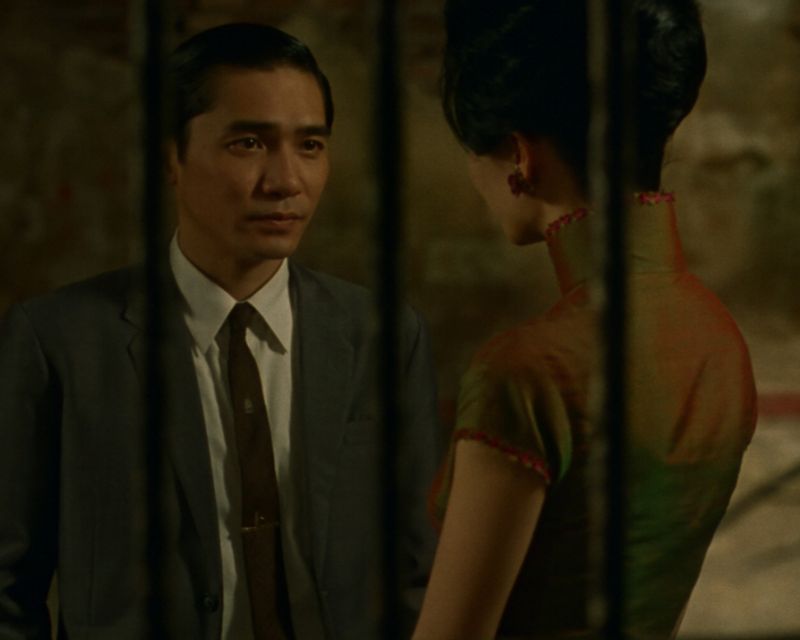THE JOURNAL

Tony Leung and Maggie Cheung in In The Mood For Love (2000). All photographs by Block 2 Distribution, courtesy Janus Films
A lonely man drifts through Hong Kong. His wife is cheating on him and he’s in love with his neighbour. He passes between neon-lit alleyways, drab offices and cramped kitchens, the clock ticking down to nothing in particular; the same songs playing on repeat. His landlady and her friends play raucous games of mahjong into the early hours. And his neighbour is in love with him, too, but these feelings settle into a quiet, aching inaction. Their shoulders brush in the back of a taxi, noodles are eaten on a bed, an umbrella is shared during a midnight downpour.
He smokes a lot of cigarettes and is, without fail, dressed immaculately.
Debuting at the 2000 Cannes Film Festival, In The Mood For Love was the film that cemented director Wong Kar-wai’s reputation as a master of Hong Kong cinema. A woozy, almost-but-not-quite love story with minimal dialogue, told over 90 minutes and painted in shades of deep red and dark shadow. As the leads, Maggie Cheung’s Su and Tony Leung’s Chow make an irresistible couple, both glamorous and forlorn.
With influences of French New Wave and films such as Alfred Hitchcock’s Vertigo and Rear Window, the premise is elegant and brutal: a man and a woman, living in the same cramped block of flats, realise that their respective spouses are having an affair, but vow not to mirror their sins. “For us to do the same thing,” they agree, “would mean we are no better than they are.” Wong called it “two people dancing together slowly”.

“The clothes are vessels of personality… from the palette to the lighting and the props”
“It is a movie about keeping up appearances,” says Chris Cotonou, deputy editor of the film journal A Rabbit’s Foot. “Largely for that period of Hong Kong; for the classes they are portraying, but even subconsciously to one another. They are also judged on their appearances, defined by them. It’s integral to the film’s identity.
“The clothes are vessels of personality,” Cotonou adds. “Moreso for Maggie Chung’s character, who had around 20 qipao dresses, each one bleeding into the frame’s composition – from the palette to the lighting and the props. As for Leung, his style has become somewhat iconic in this film. His 1960s tailoring, crisp shirts and ties are a part of his character; they also make him appear like a Cantonese Gary Cooper – the masculine Hollywood-esque hero that we can trust.”
The man behind the film’s legendary wardrobe is Wong’s longtime collaborator, William Chang Suk-ping, referred to as a “shy and quiet genius” by The New York Times in a rare interview from 2006. A multi-hyphenate art director, costume designer and editor, he begins each project by asking a simple question: “What is the ambience?”
“I just walk around, watch TV, just live and let things come,” he told The New York Times. “If you can tell that it is mine, then I should stop. Each time, I have to have moved on.”

“As the leads, Maggie Cheung’s Su and Tony Leung’s Chow make an irresistible couple, both glamorous and forlorn”
A film set in the 1960s and released at the turn of the millennium, with a look and feel that seem to have barely aged at all, Leung’s Chow dresses mostly in muted grey single-breasted tailoring, shades of charcoal and slate, with artfully crumpled long-point collar shirts and a handful of narrow silk ties in bold patterns that bring some colour to his uniform of restraint.
“I think Hong Kong cinema at that time was full of excellent style,” Cotonou says. “And they always had a grip of loose, masculine tailoring. The slick-suited Triad movies of Johnnie To, and to some extent early John Woo, reveal this. Wong Kar-wai has always been able to express character through styling. In The Mood For Love is just pure elegance.”
A regular fixture at the top of best-films-of-the-century lists, 25 years on, it has lost none of its lustre. If you can, you should see it on a big screen, where the colours practically bleed into the theatre. Each rewatch brings forth a new detail or dimension, except for the style, which is always, immediately, obvious. Few works of art have made the perceived experience of heartbreak, longing, wearing a suit and smoking indoors look quite so cool.
“Perhaps it’s because the film isn’t really about 1960s Hong Kong,” Wong told the BFI earlier this year about the enduring appeal of his masterpiece. “But about something more fundamental – how we connect with each other, how we navigate desire and restraint, how we construct narratives to make sense of our lives.
“These are questions that don’t date, that every generation has to answer for itself.”